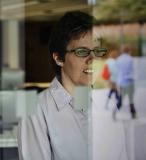What can we learn from measuring the temperature of space?
Toggle
On a clear night, when we gaze at the skies we can look back in time.
With an optical telescope, or sometimes even with just the naked eye, we see the pinpoints of light that we call stars.
What is actually meeting our eyes is energy in the visible wavelength that has travelled across space (and time) from that star or planet to us.
But what about the wavelengths that we can’t see? That ‘invisible’ energy can also tell us much about the universe and its history, if we know how to look at it. Scientists at Maynooth University ’s Department of Experimental Physics know how to look at it, and their research is helping to cast the universe in a new light.
Cool wavelengths
Dr Créidhe O’Sullivan, Prof Anthony Murphy, Dr Marcin Gradziel and Dr Neil Trappe are designing instruments to detect wavelengths in a region that lies between visible and radio waves called the ‘terahertz’ band.
“From an astronomy point of view the reason you would want to look there would be to see the cool universe,” says Dr O’Sullivan, who explains that, on average, the universe is a pretty chilly place.
“Initially, the Big Bang was very hot, but the universe has been expanding for nearly 14 billion years since then, cooling as it expands. It is now averaging just below 3 Kelvin, which is around -270 degrees Celsius, and that is ideal for our wavelength range.”
By detecting and mapping small regions of variation in temperature, scientists can pick up signatures from the formation of planets and galaxies. Dr O’Sullivan is particularly interested in the ‘cosmic microwave background’, a massive burst of radiation that’s thought to have been released around 380,000 years after the Big Bang. Analysing it allows scientists to peer back and glean more clues about the heady days of the early universe, she explains, and the terahertz band is a good place to go looking.
Planck and Herschel go sky scanning
The European Space Agency satellites Planck and Herschel travelled into space to record the signals in this wavelength band, and Maynooth University scientists made important contributions to the design of the onboard instruments.
“You are trying to look at something that is only 3 kelvin, but perhaps there are objects nearby like the Sun or a moon, and they interfere,” explains Dr O’Sullivan. “Also when you are designing the optics for this wavelength - the lenses and mirrors - you need to make approximations, mathematically it is quite tricky.”
But the work is paying off - during their missions the space telescopes beamed back highly useful information about the cool universe. “Both satellites worked extremely well,” says Dr O’Sullivan, who particularly notes the temperature map of the universe built up by Planck. “It has done a really good job of looking at this temperature - you won't get better than that.”
Polarisation
Planck also picked up tantalising patterns of light polarisation from the early universe. This is intriguing because such polarisation could offer evidence for the early universe inflating rapidly shortly after the Big Bang, which would fit theoretical models, explains Dr O’Sullivan.
The push is on now to search further for patterns of light polarisation. One of the big ripples so far has come out of a project called BICEP2 from a telescope in Antarctica that picked up patterns from the early universe. It’s an exciting development, according to Dr O’Sullivan, and the Maynooth University scientists are already on the case to search for more clues.
Some of those efforts are ground-based, such as QUBIC (Q&U Bolometric Interferometer for Cosmology), will also analyse polarisation data collected by a telescope in the Antarctic.
“Our specific expertise is in the designing of the optics for these telescopes - the mirrors and the lenses and how to get the radiation onto a detector,” says Dr O’Sullivan. “It is not quite the same as optical, it is not quite the same as radio and that is our niche - we tend to get invited into these projects because we can design the optics.”
Future missions
The Maynooth University physicists also have their sights set on further space-based missions. They are designing instruments for SPICA (Space Infrared Telescope for Cosmology and Astrophysics), a collaboration between ESA and the Japanese space agency JAXA, and they are working on a European project called FISICA to design a spatial interferometer telescope that will pick up the fine detail of planetary formation around nearby stars.
“Much of what we work on is for long-term projects, particularly the satellite-based initiatives, they will take 10 or 15 years,” says Dr O’Sullivan. “But we have already been involved in projects that are changing the way we look at the universe, and likewise with the current projects, you know that when it does work it is going to make huge advances in our understanding.”
